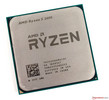AMD Ryzen 5 2600 vs Intel Core i7-6770HQ
AMD Ryzen 5 2600
► remove from comparison
The AMD Ryzen 5 2600 is a six-core desktop processor that can handle twelve threads simultaneously thanks to Simultaneous Multithreading (SMT). This technology is equivalent to Intel's Hyper-Threading. Launched in April 2018, the Ryzen 5 2600 is the second fastest Ryzen 5 processor and is much more economical than its flagship sibling. The Ryzen 5 2600 has a 65 W TDP, which is nearly 40% more efficient than the 95 W TDP Ryzen 5 2600 X. This energy efficiency comes at a cost to performance though.
The Ryzen 5 2600 has a base clock speed of 3.4 GHz, which can be boosted by Extended Frequency Range (XFR) up to 3.9 GHz. The power gain is still high in multi-threaded applications, although this is some way off the Ryzen 5 2600X. The Ryzen 5 2600 benefits from AMD's new Zen+ architecture, with a greater number of instructions per cycle (IPC) and higher clock speeds than last year's Zen chips. The Ryzen 5 2600's six cores are divided into two clusters that are connected by Infinity Fabric, a subset of HyperTransport. Each cluster has its own L3 cache.
The Ryzen 5 2600 has good performance in games. Moreover, the Ryzen 5 2600 has a higher base clock than the Ryzen 7 2700. Seeing as many games currently lack multi-core support, this means that the Ryzen 5 2600 performs better than its technically superior sibling.
Detailed information, benchmarks and values can be found in our review of the Ryzen 5 2600.
Intel Core i7-6770HQ
► remove from comparison
The Intel Core i7-6770HQ is a fast quad-core processor for notebooks based on the Skylake architecture and was introduced in the beginning of 2016. Besides four CPU cores including Hyperthreading, which are clocked between 2.6-3.5 GHz (probable Turbo steps: 4 cores: up to 3.1 GHz, 2 cores: up to 3.3 GHz), the processor also includes a very fast graphics unit. The Iris Pro Graphics 580 (GT4e) has 72 EUs as well as 128 MB eDRAM cache, which can also be used by the CPU cores. It is manufactured using a 14 nm process with FinFET transistors.
Contrary to other models like the Core i7-6700HQ, the i7-6770HQ does have a much faster GPU.
Architecture
Intel uses Skylake to replace both Broadwell as well as Haswell and therefore uses one core design for all TDP classes between 4.5-45 Watts. Several improvements of the Skylake architecture include bigger Out-to-Order-Buffer, optimizations for pre-fetching as well as bigger gains by Hyperthreading. However, the changes are small for a "Tock" – a new micro architecture – in general, so the per-MHz performance is only between 5-10 % (compared to Haswell) or less than 5 % higher (compared to Broadwell), respectively.
The i7-6770HQ also benefits from the additional eDRAM cache in some cases, which can accelerate memory-heavy applications in particular.
Performance
Thanks to the additional eDRAM cache, the i7-6770HQ should even compete with the similarly clocked i7-6700HQ and is therefore one of the fastest notebook processors in the beginning of 2016. Even the most demanding applications and excessive multi-tasking are no problem for the high-end CPU.
Graphics
The integrated GPU with the designation Iris Pro Graphics 580 (also known as "GT4e") represents the fastest version of the Skylake GPU (Intel Gen. 9). 72 Execution Units (EUs) run at 350 up to 950 MHz and allow a performance comparable to a dedicated mainstream chip. The GPU might be able to compete with a GeForce 945M under perfect conditions and it is therefore the fastest iGPU on the market by a pretty big margin. Modern games from 2015/2016 can usually be played smoothly at medium settings. More information about the performance and the features is available on our dedicated page for the Iris Pro Graphics 580.
Power Consumption
According to its TDP of 45 Watts, the chip is primarily designed for bigger notebooks starting with 15-inch screens. The TDP can optionally be reduced to 35 Watts (cTDP down), but this would obviously affect the performance.
| Model | AMD Ryzen 5 2600 | Intel Core i7-6770HQ | ||||||||||||||||||||||||||||||||||||||||||||||||
| Series | AMD Ryzen 5 | Intel Core i7 | ||||||||||||||||||||||||||||||||||||||||||||||||
| Codename | Pinnacle Riege (Zen+) | Skylake | ||||||||||||||||||||||||||||||||||||||||||||||||
| Clock | 3400 - 3900 MHz | 2600 - 3500 MHz | ||||||||||||||||||||||||||||||||||||||||||||||||
| L2 Cache | 3 MB | 1 MB | ||||||||||||||||||||||||||||||||||||||||||||||||
| L3 Cache | 16 MB | 6 MB | ||||||||||||||||||||||||||||||||||||||||||||||||
| Cores / Threads | 6 / 12 | 4 / 8 | ||||||||||||||||||||||||||||||||||||||||||||||||
| TDP | 65 Watt | 45 Watt | ||||||||||||||||||||||||||||||||||||||||||||||||
| Transistors | 4940 Million | |||||||||||||||||||||||||||||||||||||||||||||||||
| Technology | 12 nm | 14 nm | ||||||||||||||||||||||||||||||||||||||||||||||||
| Die Size | 213 mm2 | |||||||||||||||||||||||||||||||||||||||||||||||||
| max. Temp. | 95 °C | 100 °C | ||||||||||||||||||||||||||||||||||||||||||||||||
| Socket | AM4 (LGA1331) | BGA | ||||||||||||||||||||||||||||||||||||||||||||||||
| Features | DDR4-2933 RAM, PCIe 3, MMX, SSE, SSE2, SSE3, SSSE3, SSE4A, SSE4.1, SSE4.2, AVX, AVX2, BMI2, ABM, FMA, ADX, SMEP, SMAP, SMT, CPB, AES-NI, RDRAND, RDSEED, SHA, SME | Dual-Channel DDR3L-1600/DDR4-2133 Memory Controller, AVX, AVX2, Quick Sync, Virtualization, AES-NI, TXT | ||||||||||||||||||||||||||||||||||||||||||||||||
| Announced | ||||||||||||||||||||||||||||||||||||||||||||||||||
| Manufacturer | www.amd.com | ark.intel.com | ||||||||||||||||||||||||||||||||||||||||||||||||
| Series: Core i7 Skylake |
| |||||||||||||||||||||||||||||||||||||||||||||||||
| L1 Cache | 256 KB | |||||||||||||||||||||||||||||||||||||||||||||||||
| iGPU | Intel Iris Pro Graphics 580 (350 - 950 MHz) | |||||||||||||||||||||||||||||||||||||||||||||||||
| Architecture | x86 | |||||||||||||||||||||||||||||||||||||||||||||||||
| $434 U.S. |


 Deutsch
Deutsch English
English Español
Español Français
Français Italiano
Italiano Nederlands
Nederlands Polski
Polski Português
Português Русский
Русский Türkçe
Türkçe Svenska
Svenska Chinese
Chinese Magyar
Magyar